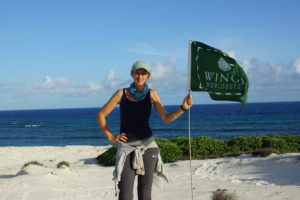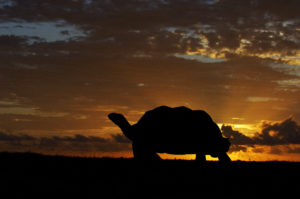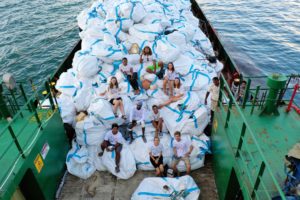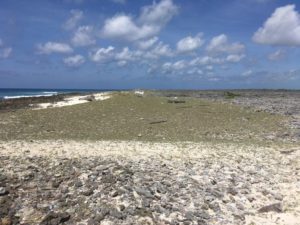How the Aldabra Atoll Changed My Life

Scientific Coordinator, April Burt, on Dune d’Messe on the south coast of Aldabra where the team was stationed.
Working in conservation management for the last eight years, I’ve traveled extensively throughout the western Indian Ocean region. One of the most unique, and life changing experiences is hands down on the remote Aldabra Atoll. Around 20 Million years ago volcanic activity created an island in the west Indian Ocean of which Aldabra Atoll would much later become a remnant. Around 300,000 years ago coral reef limestone built up in the coastal shallows around this volcanic island…. over time the volcano subsided and sea level rose and retreated to leave behind a ring of limestone that formed a doughnut shaped island; Aldabra Atoll. In time plants and animals colonized the atoll and the islands teamed with life. Aldabra was inscribed a UNESCO World Heritage Site in 1982 as it represents a superlative example of an oceanic island ecosystem – one of the last remaining such places on our planet and a refuge of stability in a very unstable world. The island has survived human settlement and long-term exploitation because It is so isolated and so inhospitable to humans, one national geographic photographer called it “the island that wants to kill you”! But I survived living there for two and a half wonderful years.
Today, Aldabra is one of the largest and most highly protected marine reserves in the region. No one lives there except a small team of staff from the Seychelles Islands Foundation who manage and protect Aldabra. The atoll is the second largest raised coral atoll in the world and to put its size into context, Manhattan could fit in the lagoon twice over. The atoll’s huge lagoon acts like a beating heart; twice daily it fills up and half empties, creating some of the fastest currents anywhere in the world. I can testify to that having dived and snorkeled these channels, the only way I can describe it is like doing a horizontal skydive but underwater. The waters hold the highest fish biomass in Seychelles and the highest apex predator abundance in the region…you cannot go on a boat trip around Aldabra without seeing sharks, turtles, rays and thousands of seabirds, as a marine biologist I was in absolute heaven. The marine realm is truly spectacular, but it was the terrestrial realm that first got scientists so hooked on Aldabra. The islands support the largest population of giant tortoises worldwide and the last remaining population in the Western Indian Ocean (there were once many). These giants roam around in their thousands; 150,000 to be exact, about ten times the amount in Galapagos.

I lived on the atoll with a team of Seychellois rangers and logistics staff. The team was never more than 15 people, and for half the year there was no transport in or out of the atoll. During the south-east monsoon season (May to October) the seas in that region are far too rough for any boats to come close – we were literally marooned, but in paradise! My job as scientific coordinator was to manage a team of research staff and oversee all the routine monitoring programs for turtles, tortoises, land birds, seabirds, vegetation, climate and my favorite, the marine monitoring. As well as regular monitoring, we conducted specific research and management projects. One of the hardest expeditions I did whilst living on Aldabra was an eradication follow-up visit to the south-eastern end of grande terre island. From 2012 to 2015, an intensive eradication project was launched here to remove an invasive species of bird that was out-competing with the endemic Aldabra species. Following this, my job was to lead a team of rangers to this area at the start of each breeding season and systematically search the area to see if there were any birds remaining. To declare the eradication successful, you have to have about two years where none have been seen. And to do this properly you have to go deep into their habitat, walking and watching for weeks.
Aldabra is harsh. It’s hot, there is no real shade, the ground is sharp limestone karst which will take your face off if you fall on it, the vegetation is dominated by dense pemphis acidula – a plant that is so hardy it flowers in the dry season. Pemphis sometimes feels like it’s alive, it makes it very easy to lose your way, it has a way of disorientating you, and sometimes will try and rip off your hat and sunglasses, tear shirts and generally let you know that you shouldn’t be there. In fact, this is how I felt by the end of these expeditions and after the last one I remember telling myself “I will never put myself through this again!”
But when I left Aldabra in late 2017 to start my PhD at Oxford, I already had plans to go back. There are two major threats to Aldabra that no amount of management and protection can defend against: climate change and plastic pollution. The most immediate impact is the increased sea surface temperatures, which periodically are rising above the level at which corals can function. This has resulted in mass die-offs; in 2016, Aldabra lost 50% of its hard coral – and it was worse elsewhere. This is like losing half a forest almost overnight. It changes the entire ecosystem, sometimes irreparably. This for me was heartbreaking to see, we were diving around the atoll in what felt like a bath tub, just watching these corals die. I wanted to scream at the world “look what we have done”…because we are doing this, these events are becoming more severe and more frequent as a result of human driven climate change.

The clean-up team onboard the vessel filled with the trash collected from Aldabra.
But one of the most visual threats impacting Aldabra is plastic pollution, which has several direct and indirect impacts. Isolated and remote Aldabra has been bombarded at an ever-increasing rate with the world’s trash. This trash has accumulated along its coastlines and clogs key habitats. The turtles are struggling to find nest spots, they are becoming entangled in discarded fishing gear and ingesting plastic. It’s the same story for tortoises and seabirds. It reflects just how far we have blindly gone towards destroying our natural world. But now our eyes are open and there is no excuse for in-action. During my time on Aldabra we would often discuss this issue and try and think up ways we could deal with the problem. But the problem was huge! In 2018, myself and my colleagues from the Seychelles Islands Foundation formed the Aldabra Clean-Up project. The project objectives were: to clean-up Aldabra, to raise awareness of the extent of the issue and how we can make societal changes, to conduct research that will provide information on the management of this threat, and to investigate ways in which we can prevent this plastic going into landfill. None of this was easy but as a team we worked together to fundraise, plan and execute this ambitious and logistically complex expedition. I’ve shared more details on the project with one of our funders, WINGS WorldQuest, which you can read here. Our experience taught us that we can as individuals make a big impact and protect our natural world and despite the ongoing onslaught of threats we are more optimistic that places like Aldabra will continue to thrive.

After the clean-up.
Aldabra’s extreme remoteness and protection means that it is not open to mass tourism, however there are a few expeditions such as Zegrahm that operate and bring tourists to the atoll to experience the majestic lagoon, the incredible channel snorkeling, and of course the prehistoric island life.
About the Author:
April Burt is currently studying for her DPhil at the University of Oxford after spending the past eight years in conservation management and research positions in the western Indian Ocean region. This included working as the scientific coordinator for Aldabra atoll, a marine UNESCO World Heritage Site. April has led expeditions and teams now for many years and is now leader of the Aldabra Clean Up Project, for which she carried the WINGS WorldQuest Flag to celebrate women in science and exploration. She is also a member of the IUCN commission on ecosystem management in the island ecosystems specialist group and she has authored or co-authored several scientific publications specializing in both marine and terrestrial tropical habitat conservation.
